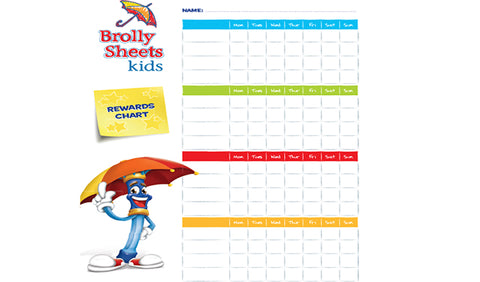This is a tricky one. Some parents love rewards and say they are the only way to go, whether its stars on a chart or lollies. Others believe it’s a slippery slope and something not to even start. Certainly, praise for success is a good thing and punishments for accidents are not.
This is up to you, as you know your own child and what works best for them. Sometimes even taking action and making up a reward chart is enough to show the child that you care and are willing to help them get through this difficult phase. Rewards can help to reverse the negative emphasis on wet beds. Brolly Sheets has a free downloadable rewards chart you can print here. We made it in word so you can edit it. Download some of our range of
helpful reward charts. Use the code PRINTFREE1 and get the reward chart FREE.
Star Charts for Bed Wetting
Rewards can be used to reinforce behaviour aiming at dry nights and helps to maintain self-image. Star or sticker charts are a reward system to encourage desired behaviour changes, such as going to the toilet before bed.
Reward charts can help change the behaviours that can have an influence on bedwetting but only sometimes help cure the actual wetting.
They can be useful for decreasing the impact on the parents - for example, older children can easily remove a
Brolly Sheet during the night, get changed into dry pyjamas and go back to sleep, all without disturbing mum or dad. By rewarding this helpful behaviour, the bedwetting becomes far less of a problem for everyone. Rewards should be used with lots of praise smiles and hugs.
Sometimes a positive comment e.g. "I like the way you go to the toilet before bed" combined with a hug is all that is required.
What Behaviours to Reward
-
Keep things simple and reward effort rather than the result - remember keeping the bed dry is not directly under the child's control
-
Behaviour rewarded needs to be defined, clear and observable
-
Reward small steps - break the behaviour down to achievable goals
-
Allow early success and rewards
-
Avoid different rewards for different behaviours
-
Highlight behaviours one at a time
-
Change the menu from time to time
Examples of Behaviour That Can be Rewarded
-
Going to the toilet before bed
-
Getting up to go to the toilet
-
Getting up to the alarm
-
Helping to change wet sheets
-
Stop functional payoff e.g. not going to parents' bed after wetting.
-
Not having temper tantrums
Be Careful!
- Stop if your child is bored or can't achieve goals, this can undermine their confidence
- Review the information on how to tell if your child is ready to be dry at night! Many children are not ready until well after they are 4 years old, and trying to 'train them' with a sticker chart will not work if they are not physically capable of staying dry - especially true with boys!
How to reward
- Make the chart interesting and attractive, (or download a free version of our charts)
- An older child may prefer a diary
- Negotiate rewards the child truly values, but do not "break the bank."
- A limited choice of items gives mastery
- Allow your child to reward the whole family e.g. play at the park, video rental
- Immediate reinforcement is best - use a token or sticker to swap later
- Once the reward is given, it should not be taken away
- Always give praise and encouragement
Examples of rewards:
Best rewards cost time rather than money. These might be given after 10 stickers on the chart.
- Special time with parents, e.g. 10 minutes extra playtime with parents
- Extra privileges at home, e.g. choosing a dessert for family
- Special activities outside
- Trip to park
- Choosing a favourite cereal at the supermarket
- Coin or $2 shop
Our thanks to the Bedwetting experts at
The Continence Association for this excellent information










